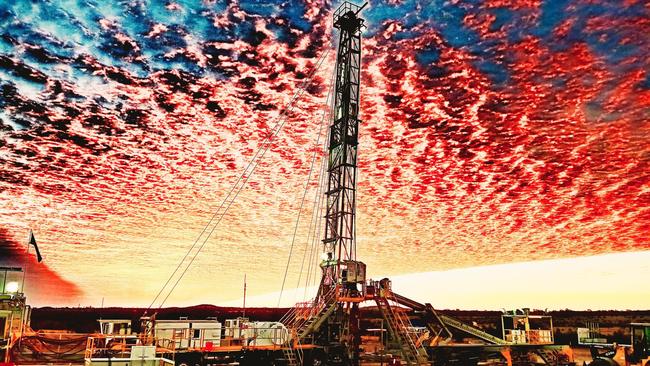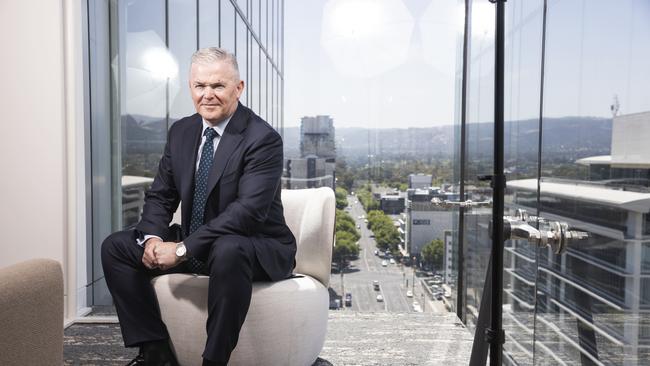Santos profit triples to $1.32bn on energy price boom, just weeks after wrapping up $21bn Oil Search merger
The South Australian energy group has delivered a major annual profit boost just weeks after sealing its $21bn merger with Oil Search.

Geopolitical tensions between Russia and Ukraine, and China and Taiwan, and an ongoing global supply squeeze means oil and gas prices will stay high over the short to medium term, Santos chief executive Kevin Gallagher predicts.
Crude is charging towards $US100 a barrel while Asia LNG prices are trading five times higher than a few years ago at $US25 per million British thermal units.
The price momentum has turbocharged earnings for Australia’s big energy producers including Santos and Mr Gallagher expects the two commodities to remain high for some time.
“Ultimately the midterm, up to five years, I think we’re seeing stronger prices and that is structurally driven.
“Right now I’m not sure if this is the right price. I think you’ve seen the Ukraine political situation and some tension about China, Taiwan. All of those things are just adding to a sense of unease and market concern, which is maybe inflating the price a little bit, as undoubtedly there is very little sort of headroom or slack between the supply and the demand at this point in time,” Mr Gallagher said on a media call.
“But I just don’t see big chunks of supply coming to the market to arrest that in the short term so I think we’ll see stronger prices for a bit longer, but I would never bet on it and I would never count on it.”
Santos more than tripled its annual 2021 underlying profit amid stronger energy prices and plans to sell assets potentially topping $4bn after sealing a blockbuster merger with rival Oil Search and delivering a bumper dividend to investors.
The South Australian producer revealed it had received early interest from buyers to take a stake in its Papua New Guinea LNG project as it weighs a bigger program to selldown its oil and gas projects across PNG, Alaska and Western Australia.
Mr Gallagher is working through a laundry list of asset sales as it looks to boost its balance sheet and reduce its future capital spend as projects moved to the drilling and production stage.
Santos now owns 42.5 per cent of PNG LNG, a higher share than operator ExxonMobil, and noted there had been early interest from the market. Both Exxon and France‘s TotalEnergies, which operates Papua LNG, are expected to be interested in scooping up a share.
“In the case of PNG, it‘s a very attractive asset. Since announcing that, you can imagine we’ve already had some interest in that assets, but we’re at 42.5 per cent,” Mr Gallagher told analysts.
Santos has also reopened a selldown process started by Oil Search for the Pikka asset in Alaska and will consider trimming its 80 per cent stake in the Dorado oil project in Western Australia.
“There’s a number of assets that we’ve got very high equity levels in and there’s a lot of options across the portfolio. Ultimately, we’re very heavy in PNG, we’re heavy in Alaska. And of course, we’re still quite heavy in Dorado.”
“So I’m not going to give a specific target range for each individual asset because we’ll wait and see what offers we get and ultimately if we sell down more or less for one asset, we may not have to sell down as much in another and, and we’ve got a lot of options. I want to use that to provide a bit of price tension as well through that process.”
Annual underlying profit surged by 230 per cent to $US946m ($1.32bn), beating consensus forecasts of $US933m, due to a 60 per cent surge in its average oil price to $US76 a barrel.
Revenues rose 39 per cent to $US4.7bn, propelled by the recovery in crude prices and a 45 per cent lift in its average LNG price to $US9.25 mbtu.
The result only captured three weeks of the merged company trading as one business, with Santos noting the combined assets would have generated over $US2.3bn in free cash flow for the year if the merger had been in place for all of 2021.
Santos will pay a dividend of US8.5c, up 70 per cent on a year earlier with Jarden describing it as a solid result.

“Headline beat thanks to the exclusion of hedging losses and Oil Search acquisition costs. Production guidance may disappoint but Santos can fund all 2022 major growth out of free cash flow at $US65 per barrel oil,” Jarden analyst Nik Burns said.
Santos has targeted cost saving targets of up to $US115m ($161m) a year and said it had achieved $US30m so far in synergies through corporate overheads with a review of its organisational structure due to be unveiled by June.
Santos expects 2022 production to increase to a range of 100-110m barrels of oil equivalent due to Oil Search’s PNG LNG being added in although Bayu-Undan production will be 10m barrels less from a year earlier following its decision to sell a quarter stake in the project and lower production.
Sales volumes in 2022 are expected to be in the range of 110-120 million boe with sustaining capital expenditure of $US900m for the financial year and restoration expenditure of $US200m.
Major growth projects capital expenditure is seen in the range of $US1.15bn to $US1.3bn and a contingent amount of up to approximately $US400m could be added should the Dorado project in WA and Alaska’s Pikka development take final investment decisions.
Santos’ own executive ranks may also come under pressure as Mr Gallagher works to name a new management team to lead the merged company.
Three logical successors to Mr Gallagher – chief technical and marketing officer David Banks and Santos’ two chief operating officers for upstream and midstream, Brett Darley and Brett Woods – could be candidates for the vacant Beach Energy CEO job, The Australian’s DataRoom reported on Wednesday.
Meanwhile, Oil Search’s top executives have quietly left the company just weeks after completing its $21bn merger amid expectations its head office in Sydney will also shut. Mr Gallagher confirmed there would be job cuts from the former Oil Search Sydney office but said numbers had not yet been concluded.
Santos shares fell 2.8 per cent on Wednesday to $7.19.






To join the conversation, please log in. Don't have an account? Register
Join the conversation, you are commenting as Logout